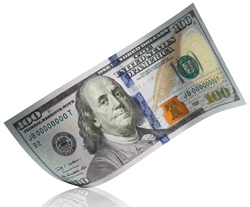A C-Note Worth Seeing: Alumnus Makes Money Making Money
-
-
slice.mit.edu
Filed Under
Recommended

There are lots of ways to earn money. Douglas Crane MBA '98 literally makes it. The former Sloan Fellow hails from a distinguished line of paper makers—his family has been producing Crane & Co. cotton papers for hundreds of years. You've likely heard of Crane stationery. But did you know that Crane and Co. has continuously supplied the United States Treasury with its currency paper—and an evolving array of embedded security features—since 1879?
It even supplied paper for money before a national currency existed. Paul Revere engraved banknotes for the Colony of Massachusetts Bay on Crane paper to help finance the American Revolution.

Crane, who has a background in biotechnology and a master's in paper science in addition to his MIT degree, is VP of the company. The most recent work of art is a redesigned $100 bill, slated to be released in 2011. New anti-forgery features include the 3-D security ribbon (the blue strip shown right) and the bell in the inkwell.
The security ribbon is woven into the paper, not printed on it, and shows bells and 100s morphing into one another and shifting vertically and horizontally as the paper is tilted. According to the Boston Globe, this new security ribbon is the most advanced and costly technology in the new bill, containing "more than a million, microscopic lenses on the surface. Each lens acts like a tiny projector, magnifying the ink images printed underneath." Tilting the note also causes the bell in the copper inkwell to change color from copper to green, which makes the bell seem to appear and disappear.
There are also more recognizable security features: watermarks, microprinting, raised printing, and threads that glow under ultraviolet light. Another difference? The back of the new bill will show the back of Liberty Hall instead of the front, as is shown on the current bill. And, a large gold 100 on the back will make it easier for visually impaired individuals to distinguish the denomination. Check out all the new features on a cool interactive display.
According to the Boston Globe, currency paper is mostly how Crane and Co. makes its money. Almost a third of the company's revenue comes from its U.S. government contract, even more from foreign governments, such as Sweden, to make their currencies.
Read more about Douglas Crane, the challenges involved in creating the new Benjamin, and his commitment to environmental responsibility in a profile in the Sloan Fellows Alumni Newsletter.







